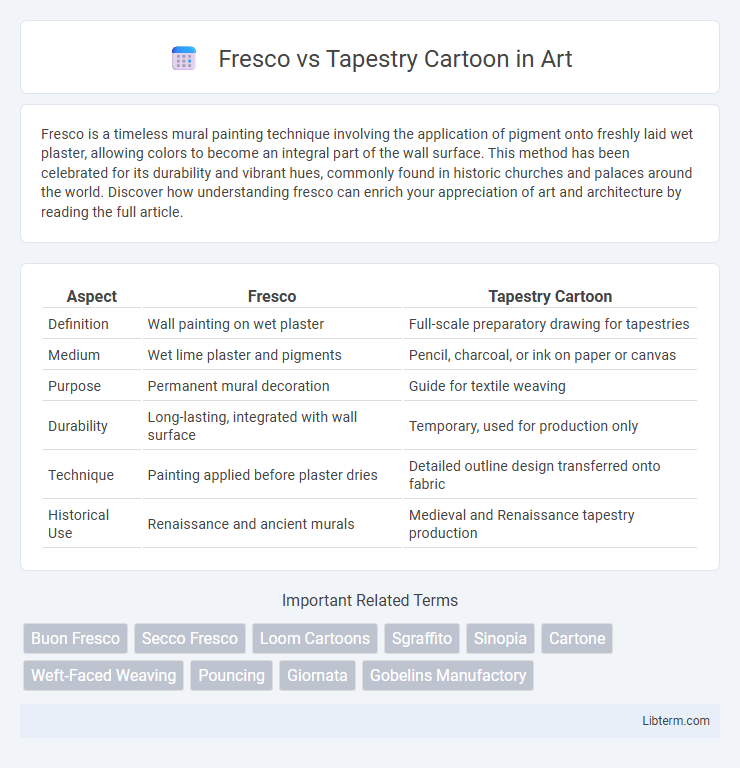Fresco is a timeless mural painting technique involving the application of pigment onto freshly laid wet plaster, allowing colors to become an integral part of the wall surface. This method has been celebrated for its durability and vibrant hues, commonly found in historic churches and palaces around the world. Discover how understanding fresco can enrich your appreciation of art and architecture by reading the full article.
Table of Comparison
| Aspect | Fresco | Tapestry Cartoon |
|---|---|---|
| Definition | Wall painting on wet plaster | Full-scale preparatory drawing for tapestries |
| Medium | Wet lime plaster and pigments | Pencil, charcoal, or ink on paper or canvas |
| Purpose | Permanent mural decoration | Guide for textile weaving |
| Durability | Long-lasting, integrated with wall surface | Temporary, used for production only |
| Technique | Painting applied before plaster dries | Detailed outline design transferred onto fabric |
| Historical Use | Renaissance and ancient murals | Medieval and Renaissance tapestry production |
Introduction to Fresco and Tapestry Cartoons
Fresco painting involves applying pigment onto freshly laid wet plaster, creating vibrant, long-lasting murals that integrate directly with the architectural surface. Tapestry cartoons are detailed full-scale preparatory drawings used as templates for weaving intricate textile artworks, primarily in wool and silk. Both techniques serve as foundational methods in art history, with frescoes emphasizing mural permanence and tapestry cartoons guiding woven narrative compositions.
Historical Origins and Evolution
Fresco painting traces back to ancient civilizations like the Minoans and Romans, evolving through the Renaissance as a prominent mural technique using water-based pigments on wet plaster. Tapestry cartoons emerged in the late Middle Ages and Renaissance as detailed full-scale drawings serving as templates for woven tapestries, integral to textile art and decorative storytelling. Both mediums demonstrate a unique blend of artistic skill and historical significance, reflecting the cultural and technological advances of their respective periods.
Techniques Used in Fresco Cartoons
Fresco cartoons employ a precise technique where the artist draws full-scale preparatory sketches on paper, which are then transferred onto wet plaster walls by pouncing or incising methods. This allows for accurate placement of figures and details before applying pigments in the fresco painting process, ensuring durability and color vibrancy. The technique emphasizes layering and absorption of pigments into the lime plaster, creating a long-lasting, integral bond that distinguishes fresco cartoons from tapestry cartoons, which rely on woven textile images.
Methods of Creating Tapestry Cartoons
Tapestry cartoons are created through meticulous design processes involving large-scale, full-color drawings that serve as precise templates for weaving intricate patterns and scenes. Artists employ detailed hand-drawing techniques, often on paper or canvas, using watercolor, ink, or gouache to establish color guides and contours essential for the tapestry weavers. This method contrasts fresco painting, where pigments are applied directly onto wet plaster, making tapestry cartoons unique as preparatory artworks integral to textile production rather than direct wall decoration.
Key Differences Between Fresco and Tapestry Cartoons
Fresco and tapestry cartoons differ primarily in their medium and application; fresco involves painting on wet plaster to create durable wall murals, while tapestry cartoons serve as detailed preparatory drawings for weaving intricate textile artworks. Fresco emphasizes color permanence and direct application on architectural surfaces, whereas tapestry cartoons focus on design transfer, guiding artisans in crafting woven images with fine thread detail. The artistic process in fresco is immediate and integrates with the building structure, contrasting with the layered craftsmanship required for converting cartoons into tapestries.
Iconic Artists and Masterpieces
Fresco painting, epitomized by iconic artists such as Michelangelo with his masterpiece "The Last Judgment" in the Sistine Chapel, showcases vibrant, long-lasting murals created by applying pigment to wet plaster. Tapestry cartoons, exemplified by figures like Raphael, were full-scale preparatory drawings used to guide weavers in producing detailed textile artworks such as "The Acts of the Apostles." Both mediums highlight the intricate collaboration between artists and artisans in creating enduring, large-scale visual narratives celebrated in art history.
Functions and Roles in Art Production
Fresco painting involves applying pigment onto wet plaster, enabling the artwork to become an integral part of the wall surface, which ensures durability and vibrancy over time. Tapestry cartoon serves as a full-scale preparatory drawing that guides the weaving process in tapestry production, ensuring accurate color and detail replication. Both techniques play critical roles in art production by influencing the material execution and visual impact of monumental artworks.
Material and Artistic Challenges
Fresco painting involves applying water-based pigments onto freshly laid lime plaster, demanding precise timing and swift execution to ensure pigment absorption and longevity. Tapestry cartoons require artists to produce detailed, full-scale designs on paper or canvas that guide weavers, posing challenges in translating fine artistic details into textile form without color blending. Material-wise, frescoes rely on durable plaster surfaces creating a permanent bond, whereas tapestries use dyed threads, which can fade or wear, complicating artistic preservation and fidelity.
Preservation and Conservation Issues
Fresco preservation faces challenges due to its direct application on wet plaster, making it highly sensitive to moisture and environmental fluctuations, which can cause cracking and pigment fading. Tapestry cartoons, woven textiles serving as design templates, are vulnerable to fiber degradation from light exposure, dust, and pests, requiring controlled humidity and careful handling for conservation. Both mediums demand specialized conservation techniques, but frescos often require structural stabilization of walls, while tapestries benefit from textile-specific climate control and restoration methods.
Modern Relevance and Influence
Fresco and tapestry cartoons continue to hold modern relevance through their influence on contemporary mural and textile art, respectively. Fresco techniques inspire large-scale public art projects emphasizing durability and integration with architectural surfaces, while tapestry cartoons serve as detailed blueprints for intricate woven designs that blend traditional craftsmanship with modern aesthetics. Both methods shape current artistic practices by preserving historical techniques while adapting to evolving cultural narratives and visual storytelling.
Fresco Infographic

 libterm.com
libterm.com